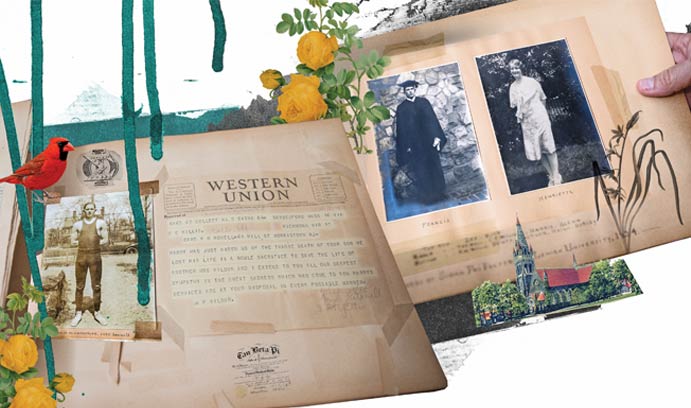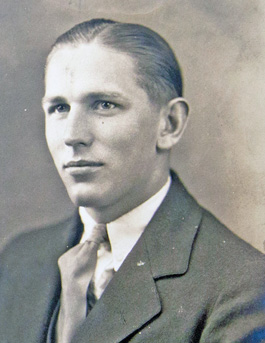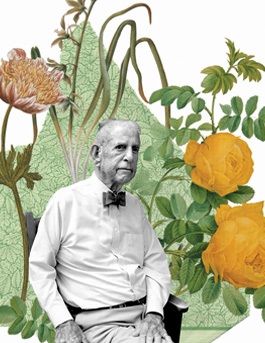A Hero's Story, Finally Told

Four days after graduating, Francis Willis '28 died while saving a 9-year-old boy from drowning. His heroism still reverberates today.
Time has tarnished the small bronze plaque in a shadowy corner of Packer Memorial Church. The crowds that occasionally fill the 131-year-old campus church for weddings or baccalaureate services typically pass it by without a glance. The names it bears and the tragedy it commemorates have been forgotten.
But that pentagonal tablet, with its simple dedication and brief biblical reference, is a portal to a vanished world and to a nearly unknown story so rich in virtue, history and fate—both unimaginably cruel and providential—that it seems drawn from the Greek mythology its doomed hero read so fervently as a child.
On the afternoon of June 16, 1928, Francis MacLeod Willis, a popular wrestler who'd graduated four days earlier as Lehigh's top civil-engineering student, drowned while saving the life of a 9-year-old boy. It was Willis' 21st birthday.
While its details, like the etched words on the plaque, get blurrier each year, the consequences of that valorous act have rippled through the decades, in part because, 88 years later, the youngster Willis rescued from the St. Lawrence River survives.
At 97, Richard MacSherry continues to repay the world for his good fortune. MacSherry, who attended Lehigh for one year until World War II drew him away, is a multimillionaire philanthropist. Inspired by Willis' sacrifice, the long-retired freight company owner has donated millions to hospitals, libraries and nature preserves near his homes in Florida and upstate New York.
"To me," MacSherry said recently at his lakeside condominium in Mount Dora, Fla., "I really haven't paid back very much at all. ... Francis Willis deserves as much credit as we can give him."
No tragedy is ever well-timed, but this one seemed particularly cruel, befalling Willis just as his promising life was taking form.
He died not just on his 21st birthday and four days after he'd graduated from Lehigh, but six days after he'd become engaged and two weeks after he'd accepted a job with Philadelphia's powerful Reading Co.
The story of that fateful intersection of Willis and MacSherry is filled with historic names and places. There's an old estate on Philadelphia's Main Line, a grand Victorian mansion in the Thousand Islands region, and Lehigh's Jazz Age campus. Its cast of characters includes a descendant of Martha Washington, the son of a New Jersey Congressman, the brother of a future Naval commander and D-day hero, and the family of the Pennsylvania industrialist who founded Lehigh, Asa Packer.
Through all those decades when this story was forgotten—its details entombed in a black scrapbook that the tragic hero's father lovingly assembled—MacSherry seldom spoke about the incident. "He's mentioned it only occasionally," said son Richard H. MacSherry. "It's not something he's proud of."
Now recovering from two serious heart-valve surgeries, he has put aside his native Main Line reserve and told the story publicly.
His retelling has been enhanced by a recent discovery in Williamsburg, Va. There, in a desk drawer, the widow of Willis' nephew uncovered a trove of information that sheds light on the young Lehigh graduate's short but remarkable life.
"It's amazing," said Anne Willis. "You wonder why someone hasn't done a book or movie about it."
Inside a musty scrapbook that sat unopened for decades is a brief biography of the victim composed by his father. Charles Ethelbert Willis' loving narrative concludes with this cinematic-like moment from his son's funeral:
"Suddenly high in the western sky appeared one rift in the musky clouds," he wrote. "Through the cleft, a solid beam of sunlight shot through, a great shaft of glory, and the end of the shaft rested for a moment on the flag-draped casket. At this very instant, a bird in a tree overhead sang blithely."
The Willis family, which made a fortune in iron manufacturing and cherished its Sons of the American Revolution membership, had deep and distinguished roots in New Jersey.
Born in 1907 in Richmond, Va., where his father was a respected mining engineer and his mother a prominent socialite, Francis was the youngest of three sons.
"His father was very formal but a great sportsman," said Anne Willis. "He loved to fly-fish. She [Willis' mother] had had polio as a child and walked with a cane."
As a youngster, Willis was as precocious as he was privileged. By age 5, he'd read several Charles Dickens' novels.
"[At] 6," his father wrote, "his knowledge of history and mythology was really startling."
The founder of Richmond's elite McGuire's University School, where Willis graduated in 1924, called him "the most brilliant student I have ever had."
He won a scholarship to Lehigh, where his father had gone and where an older brother, Charles, was also then enrolled as an engineering student. The third brother, John, a young Naval officer at the time, would later earn a French Legion of Honor medal for commanding an assault transport, the USS Henrico, on D-day.
Photos, documents and letters from Willis' Lehigh days—all preserved in the scrapbook—portray a young gentleman of ambition and manners on a growing campus where both were prized attributes. One of his first letters home from Bethlehem was a pledge to his father:
"I promise ... the following," Willis wrote, "that while at Lehigh University, I will write home at least once each week, that I will not play cards or other games for money, that I will not borrow any money, that I will not drink any intoxicating liquor, that I will not go on any note for anybody or endorse any note for anyone."
How well he adhered to those principles can't be determined, but Willis would seem to have had little time for mischief. A civil engineering major, his course load was rigorous. In addition, he was required to attend mandatory chapel services and take physical education. He would get deeply involved in ROTC, student government and numerous social and academic organizations. And he also was a member of the wrestling team, a 135-pound freshman skilled enough to be named Lehigh's wrestler of the year.
The posthumous scrapbook biography quotes an unnamed fellow student as telling Willis' father, "No one in Francis' class was a competitor of his in any way as he stood so high above any of us."
Described in the 1928 Epitome as having a "genial smile, ready wit and sincerity of purpose," Willis was especially attached to his fraternity. The now-defunct Sigma Phi, in whose house at 536 Delaware Avenue he resided for most of his four Lehigh years, introduced Willis to two well-connected friends: Ryan Fort was the son of New Jersey Congressman Franklin Fort and the grandson of a Garden State governor, and Harry P. Wilbur, who, like MacSherry, was a great-grandson of Asa Packer.
It would be those two who, 12 days after the drowning, discovered their friend's bloated body in the St. Lawrence River.
Willis soon outgrew his weight class in wrestling and dropped the sport. He then became the student manager for both football and track, jobs whose many duties included more than a little coaching.
During at least two of his Lehigh summers, he worked as a surveyor. One of those projects involved the construction of a massive drainage system in Virginia's Shockoe Valley.
By the end of his senior year, Willis had secured an engineering position with the Reading Co., a coal-mining and railroad concern that at the time was one of America's most prosperous corporations. He was scheduled to start his $130-a-month duties on July 16.
Two days before graduation ceremonies, on June 10, he got engaged to Henrietta Starr, the daughter of a Pottsville, Pa., mining engineer whose family's roots could be traced to George Washington's wife. On June 12, when 144 students received undergraduate degrees, Willis carried Lehigh's flag at the head of the commencement procession.
Immediately afterward, he and Wilbur left for the Thousand Islands, the archipelago near the New York-Canada border where Wilbur's family vacationed and owned considerable real estate.
"I am very much pleased with the islands," Willis wrote his mother after arriving. "It is all so beautiful [and] so quiet here that I know I shall sleep wonderfully."
The family headquarters there was the Victorian mansion on Sport Island that Asa Packer, who died in 1879, had built. Col. Harry Packer Wilbur, the father of Willis' fraternity friend, recently had purchased another island, Reveille, and built a new home there. On June 16, the younger Wilbur asked Willis to help him move furniture to his father's house.
That Saturday, MacSherry recalled, was "a very hot day." He and a female cousin assisted the older boys as they loaded furniture onto a large barge tied to the Wilburs' 27-foot motorboat. The boat was the "Wela Ka Hao," which in Hawaiian means "strike while the iron is hot." An Army officer, the elder Wilbur had once been stationed on that Pacific island.
MacSherry, a younger cousin of Wilbur's, had been born and lived for a time on Old Stone Farm, the Radnor Township estate of his grandparents. He never knew his father, and until he was 18, he and his mother spent summers at the Thousand Islands.
"It was beautiful," he said. "I loved it there."
MacSherry and Willis took seats on the barge. Near Rockport, Ontario, as they approached Reveille Island, the barge line was unhitched to ease the docking process.
"We weren't going very fast, maybe 4 to 5 miles an hour," MacSherry remembered. "I stuck an oar in the river to slow us down. Well, the water pressure was so strong it pulled me in. I went under the barge, sputtering and scared to death. If I was a swimmer, I wasn't much of one."
At that locale, according to various accounts, the St. Lawrence was between 100 and 300 feet deep and "nearly as cold as ice." Frightened, the boy struggled to stay on the surface. As he did, one of the large tourist boats that regularly traversed the river there happened to pass.
"I can remember very clearly looking up to that boat," he said. "Nobody attempted to do anything, but, of course, they didn't know what was going on. I can still see their faces. All these years later I can still see them."
Noticing the boy's distress, a fully clothed Willis dove in. There's no indication how strong a swimmer he was, but he managed to reach MacSherry, who by then was underwater. Maneuvering the flailing boy onto his shoulders, Willis moved toward the boat.
En route, they both sank below the water. Now Wilbur dove in. For a time, all three were submerged. Willis handed MacSherry to his friend, who rose and pulled the now-unconscious boy into the boat.
"The boy was revived after some time and with great difficulty," Willis' father wrote. "[Harry] again dove for Francis, but the latter had by this time reached a depth beyond human rescue."
By nightfall, Willis' parents had received the news via telegram. They sent their middle son, Charles, a new Bethlehem Steel engineer, to the site. Meanwhile, Fort got word in Buffalo, where he was attending a convention, and also headed to the Thousand Islands.
"[Francis] had a loyalty of whose equal I have never known," Fort would later write his mother from there. "I had never stopped to think of how much he meant to me, until [Saturday]."
The search—by "a large fleet of motorboats and many willing hands"—continued for nearly two weeks. Finally, sometime around 6 a.m. on June 28, Fort and Wilbur discovered the body, floating down river, a half-mile below the rescue site.
The body was sent to New Jersey where, on June 30, following a well-attended service there, Willis was buried at Parsippany (N.J.) Presbyterian Church.
"We thought we were following the orbit of a splendid star," his grieving father wrote. "Alas, we saw a brilliant meteor flash across the sky and then disappear."
MacSherry, perhaps because he was 9 and had come so close to death himself, wasn't informed of the gruesome discovery.
"I only found out much later," he said.
He and his mother would move from St. Davids to Toronto, then to Washington, D.C. After graduating from Sidwell Friends School in the nation's capital, he enrolled at Lehigh. He left in 1942, after his freshman year, to enlist in the Navy. A Seabee, he served in the Pacific until World War II's end.
Drawn back to the Thousand Islands region, MacSherry established a successful trucking company, Seaway Motor Express, in Watertown, N.Y., and built a riverside home in nearby Alexandria Bay, close to where Willis had drowned saving him.
He seldom recounted the story of his rescue, and it wasn't until he sold his business and retired in the 1980s that he started to reflect on Willis' selflessness.
"Francis Willis was a hero," MacSherry said. "I was a small boy at the time, and while I'd thought about the incident a lot over the years, for whatever reason I never really did anything about it. I had no background on his family, and I didn't try to investigate. I knew my grandparents had put a plaque in Lehigh's chapel. But it wasn't until years later that I really thought I ought to do something. So I started a scholarship program at Lehigh."
The Francis MacLeod Willis '28 Memorial Fund was established in 1981 and its earnings are used for unrestricted purposes, including scholarships.
Since then, MacSherry's charitable zeal has intensified, timing that his daughter believes is no coincidence.
"He won't talk about it," said Mary MacSherry MacWade. "But I think that because of it, he really has become quite a philanthropist."
Willis' parents, of course, were devastated. His mother, said Anne Willis, "would never be quite the same." His father seemed to deal with the tragedy by completing his son's unfinished business and by compiling the scrapbook.
He informed relatives and his son's friends of the death. He returned Francis' ROTC uniform to the Army, told the Reading Co. not to expect him on July 16 and wrote Lehigh seeking memorabilia from his time there.
Among the scrapbook's many artifacts is a photo of the just-completed bronze memorial plaque, which had been crafted at Philadelphia's D'Ascenzo Studio. It was installed in Lehigh's chapel during a dedication ceremony later that summer.
On it, a simple cross is surrounded by Willis' name, a few facts and the start of a familiar biblical verse, "Greater love hath no man ... ."
The book also contains a 1930 letter from the Carnegie Hero Fund notifying the family that it would be awarding a posthumous medal to Francis.
Starr, his fiancée, returned Willis' letters to his mother, believing they might bring her comfort. In them, this man of science revealed himself to be a romantic. In one letter, he told Starr of his tearful farewell to fraternity brothers he would "be proud and happy to die for."
Not long afterward, of course, Willis did give his life for another. In a letter to Starr just weeks before that event, he posed a question that his death— "that poignant agony," as Harry P. Wilbur termed it—would leave unanswered forever:
"I sometimes wonder why," Willis wrote, "why anything is, or should be, or was."
The Francis Willis story was originally published in The Philadelphia Inquirer. All photos courtesy of The Philadelphia Inquirer unless otherwise cited.
Story by Frank Fitzpatrick
Illustrations by Michelle Thompson
Posted on:




